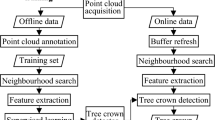Abstract
Forest fires can be the cause of serious environmental and economic damages. For this reason considerable effort has been directed toward forest protection and fire fighting.
The means traditionally used for early fire detection mainly consist in human observers dispersed over forest regions. A significant improvement in early warning capabilities could be obtained by using automatic detection apparatus.
In order to early detect small forest fires and minimize false alarms, the use of a lidar system and dial technique will be considered.
A first evaluation of the lowest detectable concentration will be estimated by numerical simulation. The theoretical model will also be used to get the capability of the dial system to control wooded areas. Fixing the burning rate for several fuels, the maximum range of detection will be evaluated. Finally results of simulations will be reported.
Similar content being viewed by others
References
G. Fiocco, L.D. Smullin, Nature 199, 1275 (1963)
R.M. Schotland, J. Appl. Meteorol. 13, 71 (1974)
F. Andreucci, M. Arbolino, Nuovo Cim. 16, 51 (1993)
A. Lavrov, R. Vilar, Application of lidar at 1.54 μm for forest fire detection. Remote sensing for earth science, ocean and sea ice applications, 3868, Bellingham, SPIE (1999), pp. 473–477
S. Pershin, W.M. Hao, R.A. Susott, R.E. Babbitt, A. Riebau, Estimation of emission from Idaho biomass fire using compact eye-safe diode lidar. Application of lidar to current atmospheric topics III, 3757, Bellingham, SPIE (1999), pp. 60–6
R. Vilar, A. Lavrov, Appl. Phys. B 71, 225 (2000)
A. Utkin, A. Fernandes, L. Costa, R. Vilar, F. Simoes, Appl. Phys. B 74, 77 (2002)
A. Utkin, A. Fernandes, R. Vilar, A. Lavrov, Forest fire detection by means of lidar. Forest fire research and wildland safety, Proceedings of the IV International Conference on Forest Fire Research (Millpress, Rotterdam, 2002), p. 58
A. Fernandes, A. Utkin, A. Lavrov, R. Vilar, Pattern Recognition 37, 2039 (2004)
C. Bellecci, I. Bellucci, P. Gaudio, S. Martellucci, G. Petrocelli, M. Richetta, Rev. Sci. Instrum. 74, 1064 (2003)
C. Bellecci, P. Gaudio, S. Martellucci, E. Penco, M. Richetta, Rev. Sci. Instrum. 76, 026115 (2005)
R. Barbini, F. Colao, A. Petri, Nuovo Cim. D 13, 143 (1991)
P.G. Gobbi, G.C. Reali, Opt. Commun. 52, 195 (1984)
C. Bellecci, F. De Donato, Appl. Opt. 38, 5212 (1999)
P. Aversa, C. Bellecci, G. Benedetti Michelangeli, G. Caputi, F. De Donato, P. Gaudio, M. Valentini, R. Zoccali, Proc. SPIE 3104, 154 (1997)
F. Andreucci, M. Arbolino, Nuovo Cim. 16, 35 (1993)
A.J. Johnson, Fuel and Combustion Handbook (McGraw-Hill, New York, 1951)
F.A. Gifford Jr., An outline of theories of diffusion in the lower layers of the atmosphere, Meteorology and Atomic Energy, ed. by D.H. Slade (U.S. Atomic Energy Commission, National Technical Information Service, U.S. Department of Commerce Springfield, 1996)
W.H. Press, B.P. Flannery, S.A. Teukolsky, W.T. Vetterling, Numerical Recipes (Cambridge University Press, New Rochelle, 1986)
A.W.M. van Schijndel, Building Environ. 38, 319 (2003)
M.J. Spearpoint, J.G. Quintere, Combust. Flame 123, 308 (2000)
F. Costa, D. Sandberg, Combust. Flame 139, 227 (2004)
R.M. Measures, Laser Remote Sensing (Wiley, New York, 1984)
R. Barbini, F. Colao, L. Fiorani, A. Paolucci, Lidar atmosferico: aspetti legislativi, scientifici e tecnologici, ENEA, Centro Ricerche, Frascati, Roma
N. Menyuk, D.K. Killinger, E. DeFeo, Appl. Opt. 21, 2275 (1982)
C. Bellecci, G. Caputi, F. De Donato, P. Gaudio, M. Valentini, Nuovo Cim. 18, 463 (1995)
C. Bellecci, S. Martellucci, P. Aversa, G. Caputi, F. De Donato, P. Gaudio, M. Richetta, R. Zoccali, Romanian J. Optoelectron. 6, 23 (1998)
C. Bellecci, L. Casella, S. Federico, P. Gaudio, T. Lo Feudo, S. Martellucci, M. Richetta, P. Vetrò, Evolution study of a water vapor plume using a mobile CO2 dial system, EUROPTO European Symposium on Remote Sensing, Tolose, France, 17–21 September (2001), vol. 4539, pp. 180–190
W.B. Grant, J.S. Margolis, A.M. Brothers, D.M. Tratt, Appl. Opt. 26, 3033 (1987)
Author information
Authors and Affiliations
Corresponding author
Additional information
PACS
42.68.Wt; 89.60.Ec; 92.60.Mt; 92.60.Iq
Rights and permissions
About this article
Cite this article
Bellecci, C., Francucci, M., Gaudio, P. et al. Application of a CO2 dial system for infrared detection of forest fire and reduction of false alarm. Appl. Phys. B 87, 373–378 (2007). https://doi.org/10.1007/s00340-007-2607-9
Received:
Revised:
Published:
Issue Date:
DOI: https://doi.org/10.1007/s00340-007-2607-9




